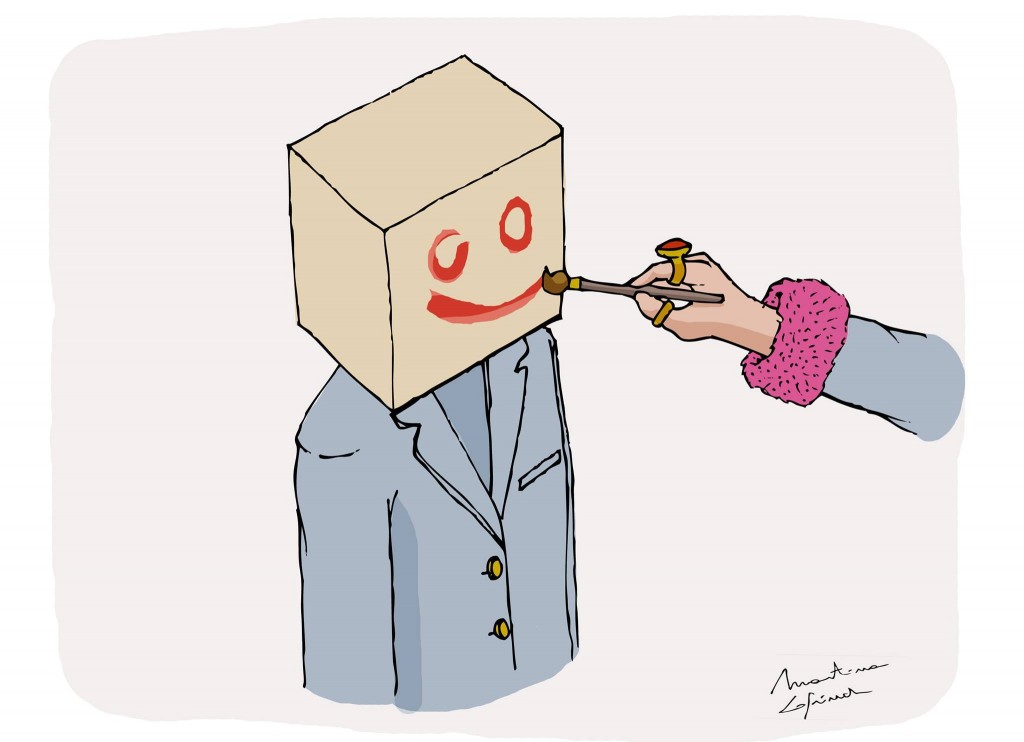
Picture by Martina Lofrinch
Psychologists believe we often choose our partner because we think (s)he has characteristics that could balance and complete ours. We need to make them play a certain role, a function of responding to our most intimate needs. Most times, this is also the role our partner needs to play. According to Monguzzi, beside the previous reasons, we also choose a partner in order to give up on some of our qualities, which are then attributed to the partner. Something like this can happen in those suffering from personality disorders: two people (with different, almost opposite disorders) can feel attracted because of their contrasting characteristics, in a sort of dance balanced by the complementarity of dispositions and roles.
According to Monguzzi, when forming a couple, we expect the partner to govern our psychological conflicts, to protect us from them. The chosen lover represents the hope to understand and deal with parts of self that we refused and try to integrate.
In couples of people who suffer from personality disorders, it’s important to remember the disorders are structured and long-lasting ways of thinking and acting, related to genetics, temperament and experiences. They aren’t just traits, they are rigid configurations that revolve around typical inflexible behavior patterns, beliefs, attitudes and expectations, which are constant and hardly modifiable. For example, while an obsessive trait can be adaptive (being a perfectionist can lead to be productive at work), an obsessive-compulsive disorder compromises the sufferer’s functioning in different, so that his life becomes too bonded to certain recurring beliefs and patterns.
While the PDM (Psychodynamic Diagnostic Manual, 2006) identifies 15 personality types (each having different levels of severity), the DSM V (Diagnostic and Statistical Manual of Mental Disorders, APA 2013) organizes 10 disorders in 3 clusters. In the first cluster we can find disorders with odd characteristics, in the second disorders with dramatic characteristics and in the third disorders with anxious characteristics.
Someone suffering from a personality disorder could feel attraction towards someone with an opposite and complementary personality structure. Scientific literature hasn’t investigated this topic much, but lots of clinicians found it regularly, especially in these three dyads: obsessive-compulsive with histrionic, narcissistic with dependent and narcissistic with borderline.
The most important characteristics of these disorders are the following:
- The obsessive-compulsive person is characterized by need to control, perfectionism and emotional inibition;
- The histrionic individual is seductive and has an excessive and drammatic affectivity;
- The narcissist shows lack of empaty, grandiosity and arrogant attitude;
- The dependent person is unable to make decisions without the other person and can’t be without him/her;
- The borderline fears abandonment, is emotionally unstable, experiences feelings of emptiness and rage and is often impulsive.
Kaslow says that in 30 years of clinical activity he found lots of stoic and meticulous obsessive-compulsive people attracted to chaotic and bubbly histrionics. Or self-absorbed and self-centered narcissists in a relationship with a needy dependent person.
The psychologist says that, in these cases, the partners are so complementary that, after a divorce, they would probably be in new couples with people that match the previous partners’ characteristics.
Solomon noticed that, even if only one of the partners suffers from a personality disorder, the other will show opposite personality tendencies. So the partner who has not a disorder still shows characteristics that complement the other person with rigid and disturbed personality. As we can imagine, this will probably amplify – not reduce – the pathological characteristics of the partner who has the personality disorder (as can be seen in sadomasochistic dyads, in which each role reinforces the other).
Concerning the OCD-histrionic disorder dyad, Kaslow explains that is likely for a histrionic woman to be attracted by a perfectionist partner with OCD, because she feels the need to be more stable, while he is probably attracted by her eagerness to care.
Carlson talks about a “private pact”, which can be summarized as: “I can’t do it alone in life, but if I find someone who makes up for my failings, maybe we can function together as a complete and adequate person”. According to the author, a histrionic woman, who is frequently at the mercy of her emotional shifts, looks for a man who has a clear, logical thinking and strong coping abilities. At the same time, the obsessive man is attracted by her generosity, her capability to just let go and have fun (which this man finds hard because he is too focused on his sense of duty).

Picture by Martina Lofrinch
However, this match doesn’t last long. After a while, one of the partners will feel threatened and will become defensive; the partner’s once fascinating qualities will be seen negatively. The histrionic woman won’t see him anymore as stable, trustworthy and organized, but as weak, cowardly, domineering and inflexible. The obsessive man won’t see her anymore as a free spirit, but as a frivolous, carefree and reckless spendthrift. Trust begins to shake. She wants him to show emotional reactions, so she will try to provoke him, but showing affection is not natural for an obsessive man. Consequently, she will assume he doesn’t care about her and she will experience feelings of failure and abandonment. She could attack him verbally, cheat on him or even try to commit suicide. His reactions to this climax will probably be passive-aggressive: he will shut down emotionally, while feeling an inexpressible anger at the same time. He will start to feel unloved too, believing his partner only stays in the relationship because of his money or because she is afraid to leave him.
This description by Sperry and Maniacci (1998) is incredibly reminding of the movie “Eternal sunshine of the spotless mind” (2004). She is affectionate, exuberant and impulsive, while he is inhibited, rigid and hermetic. After the initial idyll, an escalation of misunderstandings, fractures, revenge and recrimination happens. As predicted by the aforementioned Kaswlow, the two will look for each other again, despite the pain and the disappointments, because the other is a desirable and irresistible magnetic pole, capable of completing their neuroses.
In the dependent-narcissist couple, the dependent woman is usually remissive and feels inadequate, so she looks for someone to subordinate to, who will reassure her, complete her and fill the void she feels.
The narcissistic man, whose grandiosity and arrogant attitude usually hides a deep insecurity, uses other people to confirm his value and needs someone who doesn’t challenge him. Millon says narcissists choose partners who are reverent, considerate and condescending. Dependants, on the other hand, can make their partner feel important, strong and competent. Who is actually more dependent: the dependent or the narcissist?
Kaslow explains that, though people are initially attracted to what feels like their other half, this “half” actually reflects qualities they judge negatively or refuse within themselves.
Coherently, according to Lachkar, in this type of dyad each partner elicits unconscious, unsolved problems in the other. For example, in the narcissist-borderline dyad, the need to bond of the borderline woman clashes against the narcissist’s armor, which isolates him from intimacy. His refusal accentuates the shame and the fear of being used and abandoned felt by the borderline partner. Lachkar talks about a “dance” in which the narcissist’s emotional withdrawal and the borderline’s need of emotional upheavals come from childhood attachment problems.
Links thinks that the couple must find a new balance during treatment. For example, a dependent can keep fulfilling the need of admiration felt by his narcissistic partner, but must get love and support in return. Or, in a narcissist-borderline dyad, the former must learn to not amplify the impulsivity and fear of abandonment of the latter.
Carlson believes that the treatment of these kinds of couples only works when focusing on the connections between the disorders. Only after understanding why a collision has happened the dysfunctional system can be taken into account in its totality.
It looks like every one of us searches for someone who completes us, responding to our deepest and intimate needs. However, there is a risk: each partner could feed the other’s dysfunctional characteristics, roleplaying a fixed part. Instead, it would be ideal to be like a puzzle, to build again and again creatively, mixing the pieces and finding new, unexpected configurations. A relationship in which our partner can protect us from our deepest fears, but also encourage us to get involved, always exploring different sides of ourselves.
Psychologist, graduated in Clinical psychology at Turin University
Info, contacts and articles here
Bibliography
Carlson, J., &Sperry, L. (1997). The disordered couple. New York: Brunner-Routledge.
Kaslow, F.W. (1996). Handbook of relational diagnosis and dysfunctional family patterns. Oxford, England: John Wiley&Sons.
Lachkar, J. (1992). The narcissistic/borderline couple: A psychoanalytic perspective on marital treatment. New York: Brunner-Routledge.
Links, P.S., &Stockwell, M. (2001). Is couplet herapy indicated for borderline personality disorder? American Journal of Psychotherapy, 55, 491-506.
Monguzzi, F. (2006). La coppia come paziente. Milano: Franco Angeli.
Murray, B. (2004). Mixing oil and water: Psychologists often find that opposites attract in couples with personality disorders. Monitor on Psychology Vol. 35 No. 3.
Solomon, M.F. (1992). Narcissism and intimacy: Love and marriage in an age of confusion. New York: W.W. Norton.
